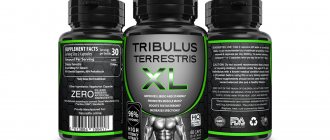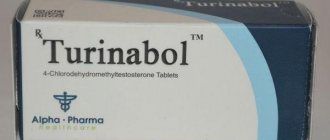Tamoxifen in bodybuilding
Tamoxifen compares favorably with its peers in that it does not belong to the group of anabolic or androgenic drugs. Its use by bodybuilders allows athletes to increase the density and definition of muscles and body weight, or to reduce them in combination with a properly selected diet.
Advice: it is important to remember and understand that an independent decision to take medications of this type is unacceptable. Prior consultation with a qualified physician is required.
According to statistics, taking Tamoxifen significantly affects the level of testosterone in the blood - after the first week of use, bodybuilders’ performance can increase by more than 40%, which confirms the effectiveness of this drug.
Release form and composition
The dosage form of Tamoxifen is tablets: from white to white with a creamy or grayish tint, flat-cylindrical; 10 mg - with bevel; 20 mg each - with a score and bevel (30, 50, 100 pcs. in bottles, 1 bottle in a cardboard pack; 10 or 30 pcs. in contour strip packs, 1–6 or 10 packs in a cardboard pack; by 10, 20, 30, 40, 50 or 100 pieces in polymer containers, 1 container in a cardboard pack).
Composition of 1 tablet:
- active substance: tamoxifen – 10 or 20 mg (tamoxifen citrate – 15.2 mg or 30.4 mg);
- auxiliary components (10/20 mg, respectively): magnesium stearate – 1.8/3.6 mg; lactose monohydrate – 117.2/234.4 mg; povidone – 6.1/12.2 mg; potato starch – 39.7/79.4 mg.
Tamoxifen tablets for men
The use of anabolic steroids is a common practice of bodybuilders seeking to achieve the desired physical shape as quickly as possible. The composition of most steroid drugs is dominated by a fair amount of aromatizing components, as a result of which the amount of estrogen in the human blood increases. Signs of feminization may occur, a process characterized by the following phenomena:
- changes in voice timbre in men;
- enlargement of the mammary glands (gynecomastia);
- excessive female-pattern hair growth;
- distribution of subcutaneous fat, unusual for a man.
Tamoxifen is able to prevent the negative effects of steroids due to the antiestrogenic effects of the components. It does not transform testosterone into estrogens, as is commonly mistakenly thought, but only blocks estrogen receptors in body tissues. The drug does not interfere with the aromatization process, which is especially valuable for athletes and bodybuilders in particular.
How does Tamoxifen affect testosterone levels?
So, a man has both testosterone and estrogen in his body. They are, respectively, the main male and female sex hormones. But the most important thing is that they balance each other. That is, the more estrogen, the less testosterone and vice versa.
Tamoxifen is aimed precisely at reducing estrogen levels, which is why the concentration of testosterone actively increases. And not by 5-10 mg, but by 10-20 times! True, the drug does not act quickly. Its nominal concentration in the body is achieved only after 3-5 days of administration, and the recommended course is only 2 weeks (after which a short break is taken and the program is repeated again).
How does the drug work?
When it enters the blood, it binds to estradiol, thereby preventing estrogen receptors from being activated when estrogen influences them. Simply put, the body stops responding to the female sex hormone.
At the same time, the pituitary gland automatically increases testosterone production. It, in turn, accelerates metabolism, including the breakdown of fat mass, and is also responsible for the absorption of proteins, which contributes to a sharp increase in muscle mass.
Side effects
The antiestrogenic effect of Tamoxifen is one of the main causes of adverse reactions in the body.
Advice: when taking the drug, adhere to the recommended dosage, do not violate the course duration indicated by your medical specialist.
If these conditions are violated, the athlete may soon notice changes in health, which usually include a slight increase in temperature, dizziness or rash. Swelling of the limbs and severe pain in the joints, temporary constipation are possible. Cases of decreased libido, increased fatigue and drowsiness, leading to attacks of depression and depression, have been recorded.
The following disorders of the central nervous system are also noted, affecting a significant deterioration of vision:
- cataract, i.e. clouding of the lens (complete or partial);
- retinopathy, i.e. non-inflammatory damage to the retina of the eyeball;
- keratopathy, i.e. corneal lesions associated with changes in the transparency of the eye;
- retrobulbar neuritis, i.e. inflammation of the optic nerve.
There may be disruptions in the digestive system, which manifest themselves through the following symptoms:
- nausea and dry mouth;
- gastrointestinal disorders;
- decreased appetite, in difficult cases leading to anorexia;
- hepatitis and liver infiltration.
For existing liver diseases, taking Tamoxifen can only aggravate the situation and lead to complete damage to the organ.
Recommendations for using Tamoxifen
Patients should undergo a thorough examination before starting treatment with Tamoxifen. Women should use reliable contraception when taking the drug. During treatment, the level of platelets, leukocytes, calcium, as well as indicators of the blood coagulation system should be constantly monitored. Particularly careful monitoring should be carried out over patients suffering from kidney disease, diabetes mellitus, ophthalmological and thromboembolic diseases. Tamoxifen is of little help in treating patients who have liver metastases. If swelling of the legs and vaginal bleeding occurs, the dose of the medicine should be reduced. The drug should be stored out of the reach of children, protected from light and moisture, at a temperature of no more than 25 degrees. The shelf life of Tamoxifen is 2 years.
Indications for use
Bodybuilders prefer Tamoxifen, since its action is aimed primarily at increasing muscle performance and actively increasing muscle mass. It is no less popular among athletes fighting fat deposits.
At the same time, taking the drug can have a positive effect on:
- functioning of the cardiovascular system;
- general condition of the liver;
- atherosclerosis, reducing the risk of its development.
In some cases, due to the use of anabolic steroids in the body, fluid retention can be noted, which negatively affects the normal functioning of the kidneys. In such a situation, it makes sense to continue taking Tamoxifen only after a thorough examination and passing the appropriate tests.
Similar recommendations for seeking medical advice apply to athletes who observe clear signs of feminization.
Main purpose of the drug
The main indication for use of the drug is the treatment of breast cancer. The drug Tamoxifen prevents tumor development, and the ability to block estrogen remains in the body for weeks even after a single use. The medicine has proven itself well in the fight against female infertility. The drug “Tamoxifen” is also applicable for men: reviews indicate its effectiveness in the treatment of prostate and breast cancer. The drug has also found itself in the treatment of other types of malignant tumors: kidney and ovarian cancer, melanoma and soft tissue sarcoma.
As with any medical product, there are different opinions about the drug Tamoxifen. And this medicine is well worth studying it more closely.
Mode of application
In bodybuilding, Tamoxifen is prescribed during post-cycle therapy (hereinafter referred to as PCT), most often in conjunction with Proviron, the most popular hormonal drug with androgenic activity. And if Proviron is best used during the course, then the start of taking Tamoxifen occurs in its last week and the next two.
If Proviron and similar drugs are not used during PCT, then Tamoxifen is started to be used already in the second week of the cycle of taking steroid drugs and is completed three weeks after its end. The daily dose is no more than 20 mg per day.
Advice: if the anabolic drugs used are not subject to aromatization, there is no need for aromatase inhibitors (for example, Proviron). Then it makes sense to start Tamoxifen in the last week of the cycle.
To purchase the drug at a pharmacy, you do not need a prescription from a doctor, but it is important to consider that Tamoxifen is a rare pharmacological agent, despite its popularity among bodybuilders.
Clomid (clomiphene) or Nolvadex (tamoxifen), which is better?[edit | edit code]
Yuzhakov Anton Tamaksifen VS Clomid
Yuzhakov Anton Antiestrogens
Tamoxifen Ebeve tablets N30 20 mg - average price 150 rubles Clostilbegit (Clomid) tablets 50 mg vial. N10 - average price 700 rubles Clomiger from Gerth Pharmaceuticals (30 tablets of 50 mg) Tamoxiger from Gerth Pharmaceuticals (30 tablets of 20 mg)
In this article we will try to resolve doubts about the choice between the two drugs, as well as find the differences: Clomid
or
Nolvadex
.
Clomiphene citrate
(available in pharmacies under the brand names
Clostilbegit
, Clomid) and
tamoxifen
(trade name Nolvadex) are antiestrogens belonging to the same group of triphenylethylenes. They are structurally similar and are classified as selective estrogen receptor modulators with mixed agonist and antagonist properties. This means that in certain tissues they block the action of estrogen by binding to receptors, while in other tissues they can act like real estrogen by activating the receptors. In men, both drugs act as antiestrogens in their ability to interfere with estrogen negative feedback to the hypothalamus and stimulate increased production of GnRH (gonadotropin-releasing hormone). As a result, the production of luteinizing hormone prolactin and follicle stimulating hormone by the pituitary gland will be increased, which in turn can increase testosterone production by the testes. Both drugs do this, but for some reason bodybuilders continue to think that only Clomid is good for stimulating testosterone.
Research conducted in the late 70s at the University of Ghent in Belgium clarifies the benefits of Nolvadex over Clomid in increasing testosterone levels [1]. Researchers looked at the effect of Nolvadex and Clomid on the endocrine system of healthy men as well as those with low sperm counts (oligospermia).[2] It was also found that Nolvadex, when used for 10 days at a dosage of 20 mg per day, increased serum testosterone levels by 142% of the initial level, which was comparable to the effect of 150 mg Clomid per day over the same period of time (the increase in testosterone levels was small, but not significantly, more with Clomid). We must remember that this is the effect of three 50mg Clomid tablets. With approximately the same price for 50 mg of Clomid and 20 mg of Nolvadex, we already see a difference in the price/result ratio in favor of Nolvadex.
Contraindications
Tamoxifen is a serious drug with a wide range of not only side effects, but also contraindications that cannot be ignored:
- Tamoxifen should not be used, like any other medication, if individual intolerance to any of its components is detected;
- before starting to take the drug, it is important to conduct a thorough examination of the body to identify diseases of a thromboembolic and ophthalmological nature, as well as diabetes mellitus or kidney problems, so that the drug does not aggravate their course;
- when the first signs of swelling of the legs appear, it is recommended to reduce the dosage of the medicine by half and make an appointment with a doctor if the problem does not go away on its own;
- the drug is prohibited for use for blood diseases such as leukopenia and hypercalcemia;
- Women who are breastfeeding or pregnant should also refrain from taking it.
Pharmacological group of the substance Tamoxifen
Tamoxifen
Tamoxifenum (
Tamoxifeni)
(Z)-2-[4-(1,2-Diphenyl-1-butenyl)phenoxy]-N,N-dimethylethanamine (as citrate)
Antitumor agent (anti-estrogen). Tamoxifen citrate is a white, odorless, crystalline powder. Very slightly soluble in water (1:5000), easily soluble in hot water (1:2), soluble in ethanol, methanol, acetone. Hygroscopic at high humidity, sensitive to ultraviolet radiation. Molecular weight 563.65.
Breast cancer: especially in menopausal women, in men after castration, carcinoma in situ of the mammary gland; adjuvant therapy for breast cancer. Estrogen-sensitive tumors; endometrial cancer.
History of deep vein thrombosis and pulmonary embolism during treatment with indirect coumarin anticoagulants, thrombocytopenia, leukopenia, hypercalcemia, hyperlipidemia, cataracts or visual impairment.
Contraindicated during pregnancy (pregnancy should be excluded before starting treatment).
FDA category of effect on the fetus is D.
Breastfeeding should be discontinued during treatment (it is not known whether tamoxifen passes into breast milk).
From the nervous system and sensory organs: headache, dizziness, fatigue, depression, confusion, blurred vision, corneal changes, cataracts and retinopathy.
From the cardiovascular system and blood (hematopoiesis, hemostasis): thrombophlebitis, thromboembolism, transient leukopenia, thrombocytopenia.
From the gastrointestinal tract: abdominal pain, nausea, vomiting, loss of appetite, constipation, increased levels of liver enzymes, severe liver dysfunction (cholestasis, hepatitis).
From the genitourinary system: bleeding or vaginal discharge, amenorrhea or irregular menstruation in premenopausal patients, the occurrence of reversible cystic ovarian tumor, fluid retention, itching in the genital area.
Allergic reactions: skin rash.
Other: alopecia, pain in the area of the lesion and/or in the bones, an increase in the size of soft tissue formations (accompanied by severe erythema of the affected areas and adjacent areas), hypercalcemia, paroxysmal sensation of heat, increased body temperature; with long-term use - cases of endometrial changes, including hyperplasia, polyps, intrauterine fibroids and in isolated cases - endometrial cancer.
Before starting treatment, women should undergo a thorough gynecological examination. Tamoxifen causes ovulation, which increases the risk of pregnancy, so women of reproductive age should use reliable methods of contraception (non-hormonal) during treatment and for 3 months after the end of treatment.
The drug should be stopped if bloody discharge from the vagina or vaginal bleeding appears, signs of thrombosis of the veins of the lower extremities (pain in the legs or swelling), or thromboembolism of the branches of the pulmonary artery (shortness of breath).
During treatment, it is necessary to monitor blood clotting indicators, blood patterns (leukocytes, platelets), and liver function indicators. An ophthalmological examination is recommended before and periodically during treatment.
In patients with bone metastases, serum calcium concentrations should be determined periodically during the initial treatment period (in case of severe hypercalcemia, tamoxifen should be temporarily discontinued). In patients with hyperlipidemia, during treatment it is necessary to monitor the concentration of cholesterol and TG in the blood serum.
Ineffective in treating patients with metastases (especially to the liver).
| Name | The value of the Vyshkowski Index ® |
| Tamoxifen | 0.0087 |
| Tamoxifen HEXAL | 0.0028 |
| Nolvadex | 0.0022 |
| Novofen | 0.0016 |
| Tamoxifen-Ebewe | 0.0013 |
| Tamoxifen citrate | 0.0009 |
| Vero-Tamoxifen | 0.0008 |
| Zitazonium® | 0.0004 |
| Tamoxifen (Tamoplex) | 0.0003 |
| Bilem | 0.0003 |
| Tamoxifen Lachema | 0.0003 |
| Tamoxen | 0.0003 |
| Tamoxifen citrate tablets 0.01 g | 0.0001 |
| Xingfeng | 0 |
Breast cancer is a diagnosis that many women fear. It is diagnosed more often in patients over 45 years of age. There are many reasons for this, but most often these are hormonal disorders during menopause.
This disease can be cured if you seek help from a mammologist in time. Depending on the stage of the pathology, a woman may be prescribed surgical or medicinal treatment.
The drug Tamoxifen has actively proven itself in complex therapy.
Tamoxifen is available in tablet form. They are white with a creamy tint. The shape is flat-cylindrical. Available in 10 and 20 mg doses. One package can contain 30, 50 and 100 pieces.
When developing the drug, the active substance tamoxifen was used. Additional components include:
- magnesium stearate;
- lactose monohydrate;
- povidone;
- potato starch.
How does Tamoxifen work? The drug Tamoxifen is a non-steroidal anti-estrogenic drug that has a weak estrogenic effect. The therapeutic effect is based on the ability to block estrogen receptors.
Metabolic products of the drug compete with female hormones - estrogens for binding sites with intracellular estrogen receptors in tissues:
- mammary gland;
- uterus;
- vagina;
- anterior pituitary gland;
- tumors with a high concentration of female hormone receptors.
How does Tamoxifen help? The receptor complex of the main component inhibits DNA synthesis in the nucleus, inhibits cell division, which leads to regression.
Indications
When is Tamoxifen prescribed? It is effective for the following pathologies:
- early stage breast cancer with ER positive;
- local advanced or metastatic breast cancer with ER positive;
- breast cancer, even in men after castration.
When diagnosing overexpression of female hormone receptors, Tamoxifen is used in the treatment of other tumors that are resistant to standard treatment methods.
Contraindications
Tamoxifen should not be used in the following cases:
- hypersensitivity to the composition;
- bearing a child and breastfeeding.
People should use the medication with caution when:
- insufficient kidney function;
- diabetes mellitus;
- eye diseases;
- deep vein thrombosis;
- increased concentration of lipids in the blood;
- reduced concentration of leukocytes in the blood;
- lack of platelets in the blood;
- increased concentration of calcium in blood plasma;
- concomitant treatment with indirect anticoagulants.
Tamoxifen is taken orally with a small amount of water. Tamoxifen tablets should not be chewed. The daily norm is 1 time per day.
The exact dosage is prescribed only by the doctor, taking into account the patient’s condition and the stage of the pathology.
The average dosage is 20-40 mg. Take the drug for a long time. If symptoms of disease progression occur, the medication is discontinued.
Side effects
The consequences of taking Tamoxifen arise as a result of its antiestrogenic effect. Characterized by the occurrence of the following symptoms:
- hot flashes of a paroxysmal nature;
- bleeding from the vagina;
- itching of the genitals;
- hair loss;
- painful sensations in the affected area;
- increase in body weight.
The following clinical picture is extremely rare:
- allergies, Quincke's edema;
- rise in temperature;
- sudden weight loss;
- fluid retention;
- nausea;
- constipation;
- vomit;
- confusion;
- headache;
- depression;
- increased fatigue;
- drowsiness;
- skin rash;
- visual impairment;
- retrobulbar neuritis;
- impotence, decreased libido.
Very rarely, when using Tamoxifen, interstitial pneumonitis develops. At the initial stage of therapy, local exacerbation of the disease may occur.
This manifests itself in the form of an increase in the size of soft tissue formations. Often an exacerbation is characterized by severe redness of the affected areas and adjacent areas.
These types of disturbances are transitory. They disappear after 2 weeks.
Other possible side effects of Tamoxifen include:
- limb spasms;
- increased concentration of platelets and leukocytes in the blood;
- increased activity of liver enzymes;
- increase in serum triglyceride levels.
If a patient has breast cancer accompanied by bone metastases, then at the initial stage of treatment the concentration of calcium in the blood may increase. Treatment with Tamoxifen may be accompanied by the formation of thromboembolism and thrombophlebitis.
In women, after using the drug, the following side symptoms are possible:
- irregular menstruation;
- reversible ovarian cyst;
- with prolonged use, the endometrium changes, which leads to the development of uterine fibroids, polyps, hyperplasia, uterine sarcoma and endometrial cancer.
Overdose
To date, cases of acute overdose have not been reported. If Tamoxifen is used in increased dosage, the following symptoms may develop:
- dizziness;
- hyperreflexia;
- tremor;
- unsteadiness of gait.
There is no specific antidote for Tamoxifen. If an overdose occurs, symptomatic therapy is prescribed.
special instructions
In order for treatment with Tamoxifen to have a positive effect and no unpleasant symptoms, it is necessary to follow some recommendations during therapy:
- Before starting a therapeutic course, a woman must undergo a thorough diagnosis by a gynecologist and therapist.
- The action of Tamoxifen has a positive effect on the development of ovulation. This increases the risk of conceiving a child. Women of reproductive age need to use reliable methods of contraception, but not hormonal ones. Use them throughout the entire treatment and for 90 days after the end of the therapeutic course.
- During treatment, monitor blood clotting indicators, blood calcium levels, plasma levels, liver performance indicators, and blood pressure. Visit your eye doctor every 90 days. If bloody discharge from the vagina occurs, stop taking the medication.
- In case of metastasis to bones, at the initial stage of therapy it is necessary to monitor the concentration of calcium in the blood serum. If it increases, then stop taking Tamoxifen. If metastases go to the liver, then taking the medicine is not effective.
- If symptoms of thrombosis of the leg veins occur (pain, swelling), shortness of breath, indicating thromboembolism of the branches of the pulmonary artery, then stop treatment with the drug.
- In patients with elevated blood lipid levels, monitor serum cholesterol and TG levels during therapy.
- During the therapeutic course, drive carefully and engage in activities that are potentially dangerous and require quick psychomotor reactions and increased concentration.
Advantages
Of the entire line of drugs in this area, Tamoxifen is recognized in bodybuilding as the safest among its competitors. With its activity, it does not harm internal organs, but only has a beneficial effect on the condition of them, despite the extensive list of side effects. Even long-term PCT based on the use of the drug will not cause significant damage to the body, but will only normalize cholesterol levels in the blood, which is especially important with long-term use of steroids.
Reduced cholesterol levels can significantly reduce the risk of atherosclerosis and other cardiovascular diseases, which will be appreciated by athletes who are predisposed to this type of ailment.
Pharmacological properties
Pharmacodynamics
Tamoxifen is a non-steroidal anti-estrogenic drug that also has weak estrogenic activity. Its mechanism of action is due to its ability to block estrogen receptors. Metabolites of the drug and tamoxifen itself act as competitors for estradiol, binding to cytoplasmic estrogen receptors located in the tissues of the anterior pituitary gland, uterus, vagina, mammary gland, as well as in tumor tissues. The tamoxifen receptor complex, unlike the estrogen receptor complex, does not stimulate DNA formation in the nucleus. It inhibits cell division, causing tumor cells to die.
Pharmacokinetics
Tamoxifen is well absorbed when taken orally. Its maximum serum concentration is achieved within 4–7 hours after taking a single dose. Steady-state concentrations of the drug are observed in serum after approximately 3–4 weeks of treatment. Tamoxifen is 99% bound to plasma proteins.
The drug is metabolized in the liver with the participation of the CYP2C9 isoenzyme. As a result, several metabolites are formed.
Tamoxifen is eliminated in two phases: the initial half-life is 7–14 hours, the terminal half-life is 7 days. The drug is excreted primarily in the form of metabolites and mainly through the intestines. Only a small portion of tamoxifen is excreted by the kidneys.
Flaws
Neglecting a medical examination before starting to take the drug is fraught with natural consequences.
The extensive list of serious side effects is usually not harmful to a physically healthy person, but can negatively affect the functioning of vital organs for everyone else.
The disadvantages include the speed of action of Tamoxifen on the body - the drug functions slowly, especially in the first stages of therapy.
Sports industry experts strongly recommend combining Tamoxifen with Proviron, which has fat-burning properties. Another important drawback of the drug becomes obvious - Tamoxifen alone can lead to excess weight gain.
The drug "Vero-Tamoxifen", reviews
The drug "Vero-Tamoxifen" is a domestic medicine produced by OJSC "Veropharm"; active ingredient – tamoxifen. The drug "Vero-Tamoxifen", like its foreign analogue, is used in the treatment of cancer of various etiologies. The dosages, prescriptions, and timing of taking the medicine are completely identical to the practice of using the corresponding imported drugs and give the same results. Alas! The contraindications, side effects and complaints of patients receiving treatment are exactly the same.
Some doctors put pressure on their patients
Women are increasingly refusing to take tamoxifen, especially as much more information about this drug and its side effects has become available on the Internet.
To be completely fair, some doctors diligently share the pros and cons of taking tamoxifen with their patients. Others offer solutions to some of the side effects - although usually in the form of more prescription drugs. For example, many women are offered antidepressants for mood episodes that occur as a result of taking tamoxifen .
I have heard many shocking stories from patients about what their doctors told them when they were offered tamoxifen. For example, some women were told that if they decided NOT to take tamoxifen, their doctor would have nothing to do with them. They will not be supervised and they will literally heal on their own. What kind of tactical maneuver is this?
Another thing we often hear is that after stopping tamoxifen, oncologists tell patients, “Well, don't come back to me when you get breast cancer again.”
Are you kidding? It's more like a spoiled child not making it than a qualified doctor presenting all the reasons why you should take medication or not. We are left wondering why this is happening. Why should the doctor be upset if we decide NOT to take this drug?











